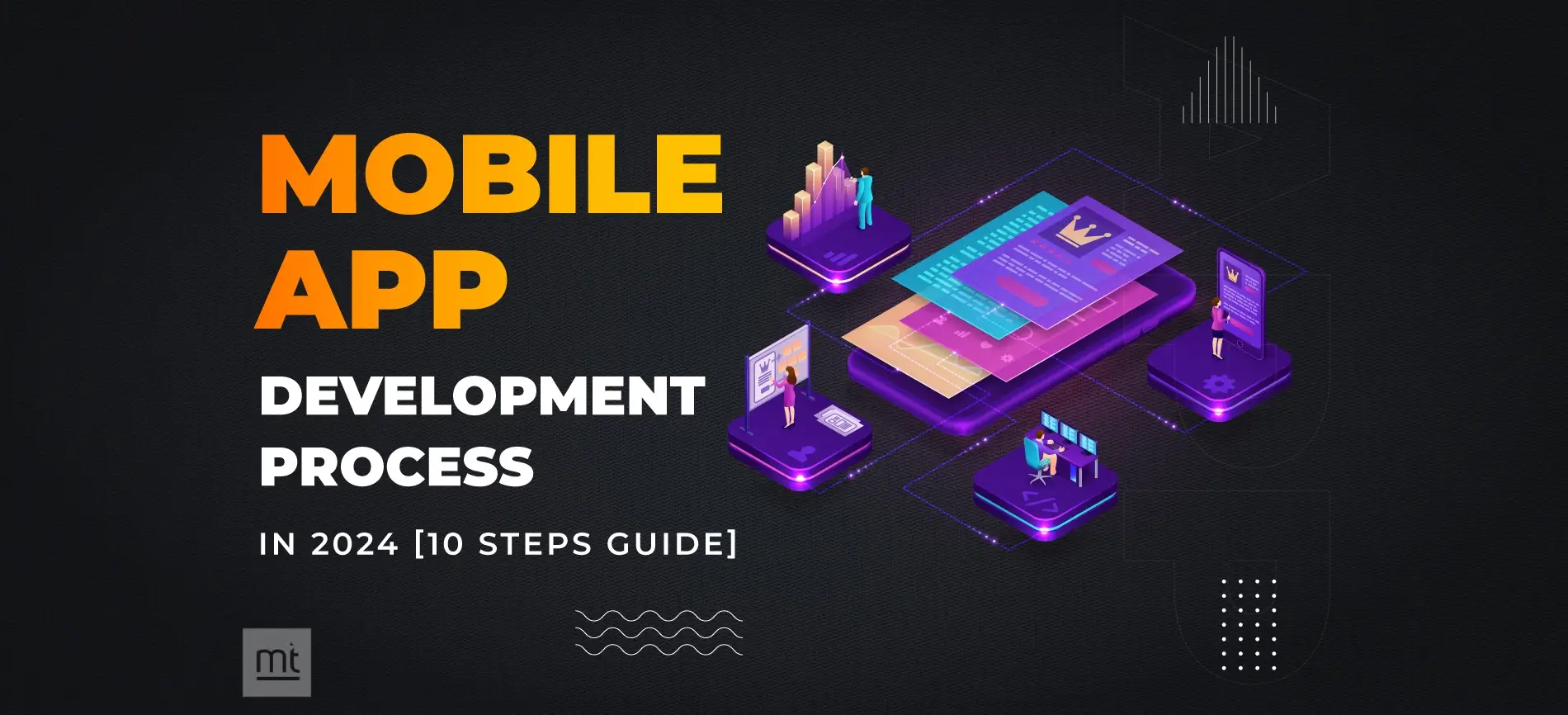Introduction:
According to Statista, the mobile app revenue is likely to reach $673 billion by 2027, highlighting the immense potential as well as intense competition in the mobile app industry. While a mobile app can lead your business to greater heights, even the most groundbreaking idea can falter if you don’t have a business plan in place.
Using a comprehensive business plan, you can overcome the challenges, such as scope creep and budget overruns. You can put a good plan in place that identifies the purpose of app, defines the target audience and determines the budget. It can help you anticipate the potential issues and detail the roadmap for your business app.
This guide will take you through a detailed mobile app business plan for the startup. We will take you through a detailed understanding of the components of the plan.
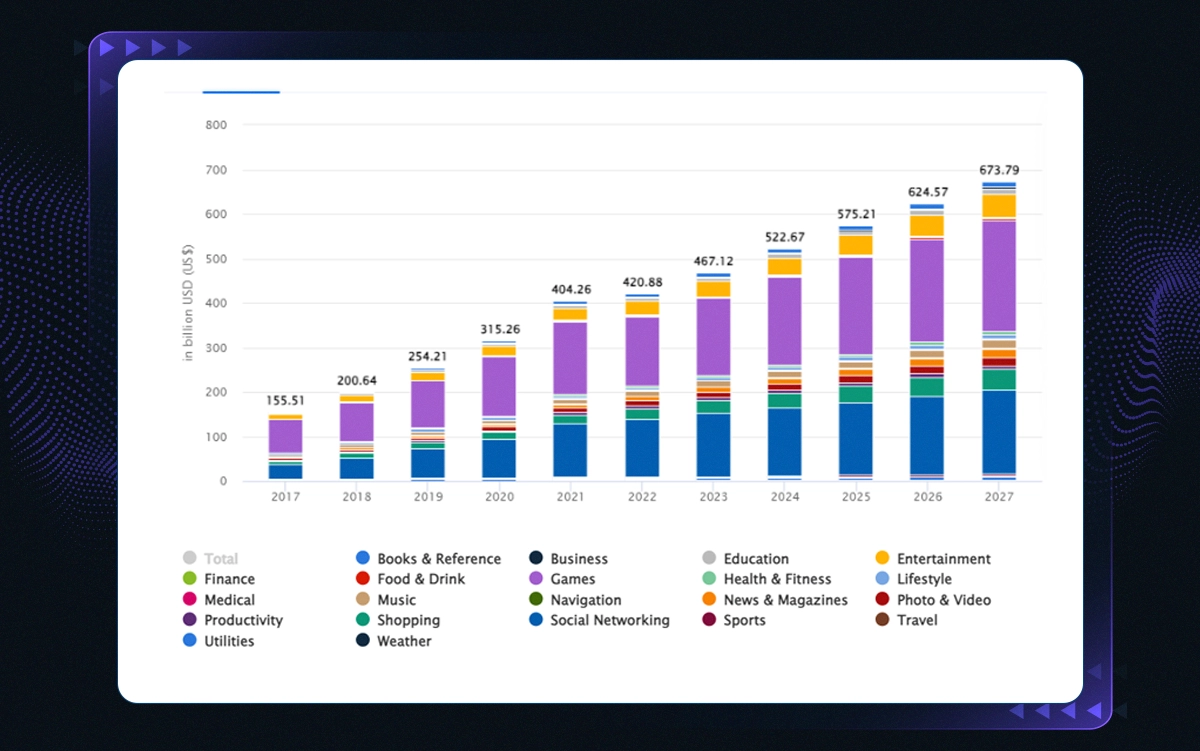
What is a Mobile App Business Plan?
A document that details the strategy, goals and development roadmap for the mobile app idea is your mobile app business plan. You can consider it as a roadmap for your project that will help in maneuvering the app journey, from concept to launch. It extends a clear vision with a structured approach that helps outline the success of your app.
The Key Components of a Mobile App Business Plan
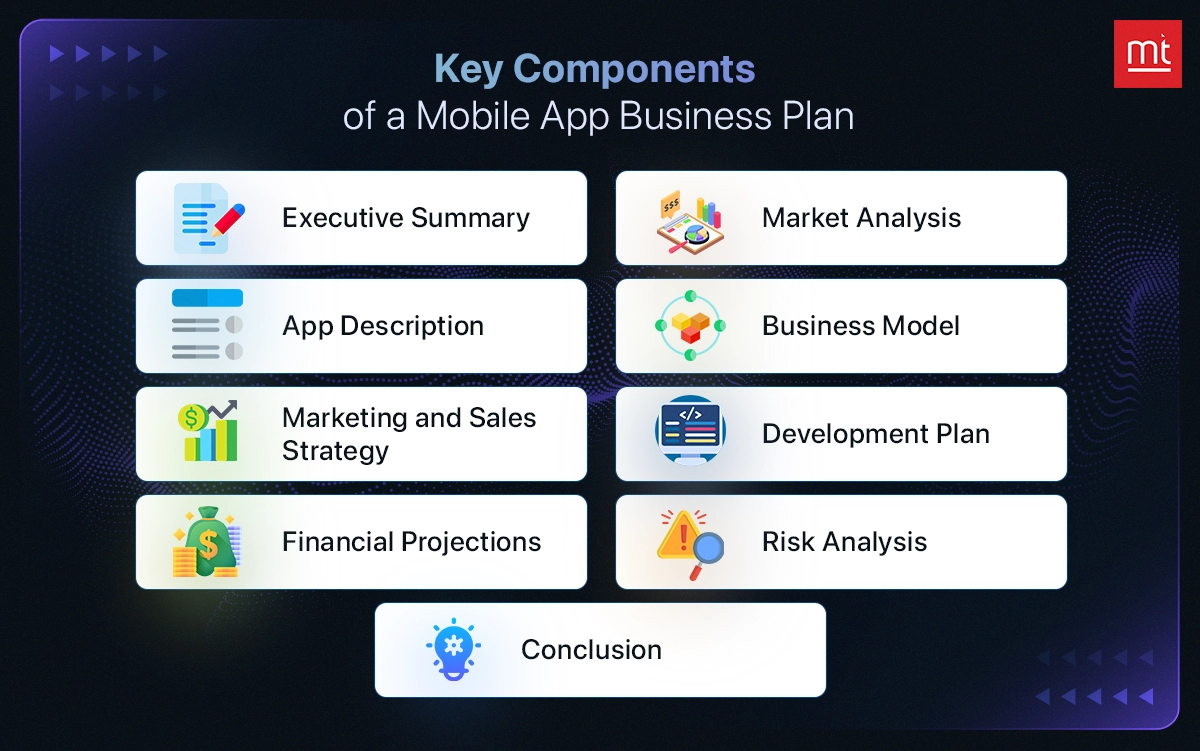
- Executive Summary: You can give a concise app overview that mentions the app’s purpose, target marketing and USPs with this component. You can use it to capture the essence of the mobile app ideas and to showcase the impact.
- Market Analysis: This section will help you highlight your findings from the detailed research you conducted to understand the competition, demographics of the audience and current mobile app development trends. It will help you identify the gaps.
- App Description: This is where you will talk about your application in detail. You will mention the features and functionality along with the benefits of using the application.
- Business Model: You must showcase how you plan to earn with the application. Business model section will outline the monetization models you plan to use, such as ads or in-app purchases.
- Marketing and Sales Strategy: Marketing and sales is crucial to app visibility. You might want to detail the promotion strategies along with the channels for the users. You can showcase the marketing channels, advertising campaigns and other sales strategies you are planning for the app.
- Development Plan: The development plan is equally important. You must mention the development timeline, tech stack and key milestones in this section.
- Financial Projections: include a detailed financial forecast that includes the projected expenses, and revenues. You can even include the funding requirements and potential investment sources.
- Risk Analysis: This section will detail the potential risks and challenges involved in the app’s success and mitigation strategies.
- Conclusion: Add a concise summary that reiterate the app’s potential and key points for the plan.
This will not only become the app development blueprint, but also a pitching document for your potential investors.
Why Do You Need a Business Plan for Your Mobile App?
Business plan for your mobile app can become a roadmap for your app business. let’s look at a few benefits to create the app plan.
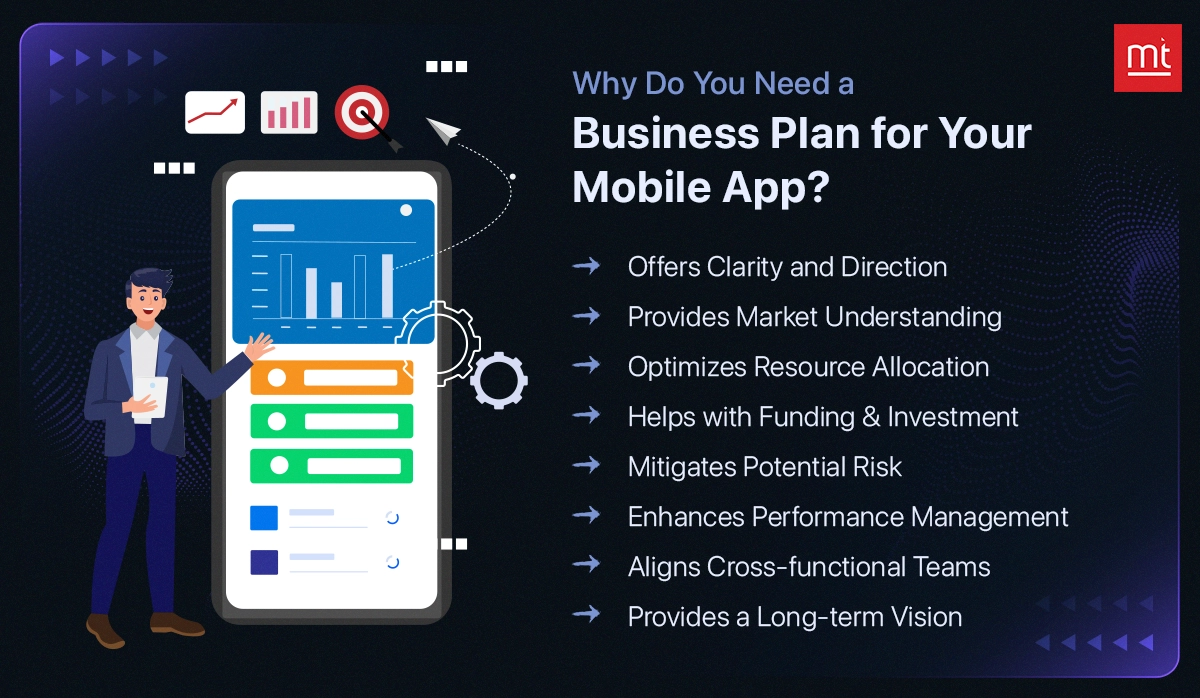
#1. Offers Clarity and Direction
A business plan provides a clear vision of your app. You can give your application the strategic direction. By using this plan, you can determine the target audience, and create the roadmap to deliver a successful application.
#2. Provides Market Understanding
Using the detailed market analysis, you conduct to create the document, you understand the competition better. You can outline the market needs and define the USPs for the application. This insight can help you position your app distinctly.
#3. Optimizes Resource Allocation
By building the business plan for an app, you can manage the resources and budget efficiently. It helps you allocate the time and money judiciously, so that it reaches where it is needed. You can manage the mobile app development costs and expenses for your marketing and development efficiently.
#4. Helps with Funding & Investment
Investors and lenders look forward to understanding the business app better. With this mobile app business plan for startups, you can showcase your market understanding and the potential profits. When you showcase these indicators, you are likely to get them interested.
#5. Mitigates Potential Risk
The business plan details the risks and challenges so that you can address the issues before they occur. This would also help you plan for contingencies and ensure that these issues don’t derail the project.
#6. Enhances Performance Management
The business plan for developing app clearly defined goals and milestones allow you to track the progress and measure the performance. you can also define the benchmarks to evaluate the marketing and development efforts for the app and check on its progress.
#7. Aligns Cross-functional Teams
Creates a detailed business plan that showcases the vision and objectives, which serves as a central point for all the teams involved. It can help foster collaboration and align with the business goals.
#8. Provides a Long-term Vision
Using the business plan, you can build a long-term growth vision for the application. It also helps you plan the future updates and scalability requirements for expanding the business.
Steps to Create a Business Plan For Your Mobile App
There are specific components within the business plan. You might want to go step by step with these components so that your plan builds up naturally. This entire section will showcase how to create a business plan for an app.
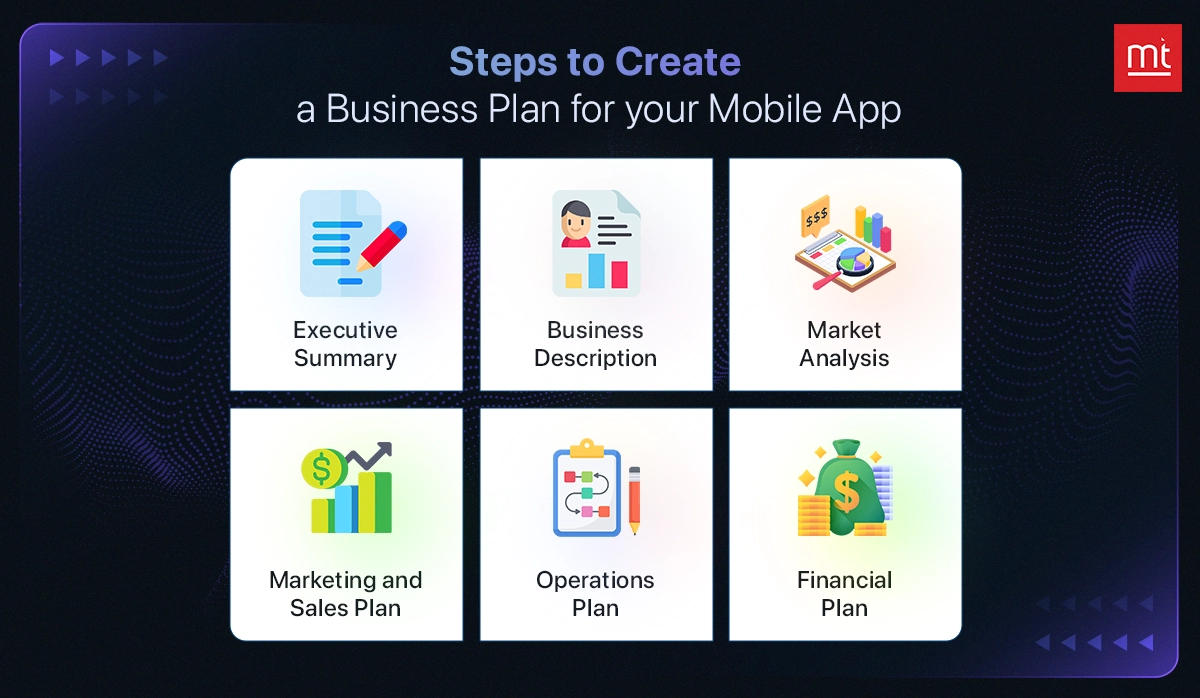
Step 1: Executive Summary
This is where you begin your business plan for the mobile app. The executive summary, as the name suggests, is a summarized version of what to expect from mobile application.
Here are the key components of this section of the plan.
(a) The App Description
The summary will address the main element of the plan- the idea and the concept of the mobile application. This will show how the mobile app idea was based and why it is going to help the users.
(b) The Target Audience
The next part of this section includes the users of the application. The summary will talk briefly about the proposed target audience and how they will benefit form the application. What is the purpose behind delivering the application. This section will also touch upon the app’s target audience definition briefly.
(c) Revenue Model
The business model will interest most people towards reading the entire document. That’s why it is an important inclusion of the executive summary. In this section, the reader will know how the business aims to make money from the application. You can study app business model of competitors to give an understanding of what works best.
(d) Key Milestones and Goals
Having discussed the purpose behind the application in brief in the earlier part of this section, it is time to address the key milestones or goals. You must mention what are some of the things you aim to achieve with this application.
At the same time, you must discuss the key milestones for the application. This means, the goals you aim to achieve in the next five months, one year and so on.
Step 2: Business Description
This next section is extremely crucial in defining the business scenario, the vision behind creating the mobile application, and what led to the creation. It talks about the business & the people behind it.
(a) Mission and Vision Statement
This is an effective way to tell the person reading the document about the application. You will showcase how you aim to help the user with the mission statement. On the other hand, the vision statement will discuss the purpose of the application in larger context. For instance, it will transform the lives or make way for convenience.
(b) Overview of the Mobile App Market
At this point, you will discuss your business from the mobile app’s perspective. You should showcase how your app vision can further the app market and create a difference.
You can also show how the current market conditions can support your vision. For instance, if the users are showing interest in using mobile apps, you might have a chance to engage better and increase your user base.
The idea is to pique the reader’s interest in your mobile app business.
(c) Detailed App Description
This is the part where you will talk about the app. You must use the adjectives that connect with the readers. For instance, if you write the app will be intuitive, it is most likely to connect with the readers as they want something that requires less learning.
Similarly, you should also connect the features with the app’s purpose to help them realize how it can help. You can also showcase the functionality that will make the application different from others.
(d) Unique Selling Proposition
Lastly, this section should talk about the app’s USP. This is very crucial if you have a large competition, and you want to ensure maximum users on your platform. Showcasing the competitive edge will help you get more users and increase profits.
Step 3: Market Analysis
A detailed market analysis is crucial to let the users know why your app will ring in the difference. You will be showing the current trends, and growth statistics. This will help you introduce the importance of your application better.
(a) Industry Overview
In this part, you will discuss the mobile app segment in detail. You can showcase the rapid advancements, key trends and the increasing opportunities available. It is also crucial to showcase how it works in your industry’s favour.
(b) Target Market Demographics
A detailed look into the target market is equally important. Showcase the diversity of the target market and tell them how each of the users will benefit from. If you have a large age group, ethnic and other diversities in the market, you can showcase the diversity as an opportunity for the application.
It is equally important to showcase the elements that the user group values for the best outcomes.
(c) Market Size and Potential
As the readers are developers, clients and investors, you might want to touch upon the market size and growth potential of the application. You should showcase numbers in this case as that will attract more attention. Tell the users how much your global usage or revenue will reach in a certain period.
(d) Competitor Analysis
You must conduct a detailed competition analysis as that can help identify the gaps and embrace the opportunities. It can also help you plan the budget and identify the points of differentiation for the application.
Step 4: Marketing and Sales Plan
The next aspect of mobile app development business plan would be the marketing and sales plans. You must define how you aim to increase the reach and visibility of the application. It is equally important to talk about defining the brand’s identity.
(a) Branding Strategy
You must start this section by defining the branding strategy. Create a unique brand identity that will connect with your target audience. At this point, you must focus on storytelling and consistency to deliver across platforms.
(b) Customer Acquisition Plan
You must have a defined customer acquisition plan that is cost-effective and completely efficient. You must include the channels that boost your acquisition strategy. you can use social media, content marketing and SEO for best acquisitions.
You can also boost acquisitions with data-driven marketing strategies.
(d) Pricing Strategy
Pricing the app is equally crucial. You must have a defined pricing strategy to start with. You can look at the competition and decide the pricing strategy. You can differentiate your app by having a value based pricing for the early adopters. You can have attractive pricing offers based on the target audience you are acquiring.
(e) Distribution Channels
The choice of distribution channels is an important one and should be aligned with the target market. you must look at the where your target market is present before defining the distribution. You can opt for app stores, and direct sales. You can also use partnerships as a way to distribute your mobile application. A detailed view into the distribution channels must be present in the plan.
(f) Marketing Budget Allocation
You should always fix a marketing budget that considers the returns on investment. Based on the marketing channels you use to distribute the application, you should have a detailed understanding of the budgets.
You should always allocate the budgets and define the key performance metrics to optimize them.
(g) Sales Forecast and Projections
The last part of this section includes the forecasts for the upcoming year. You can use market research, pricing and your anticipated conversion rate to define the yearly or monthly projections. This would help you plan the sales strategies accordingly.
Step 5: Operations Plan
The operations plan is where you define how you aim to build the application from ground-up. You will talk about the milestones for each phase and the tech stack.
(a) App Development Timeline
The first part of this section will detail the app development process. You will start with the exact timeline you are aiming for to complete the development. This will include all parts of the process, such as design, development, testing and deployment.
(b) Tech Stack and Infrastructure
The technology stack is the next part of the entire process. At this point, you will discuss the programming languages, frameworks and infrastructure requirements for the application development. You must consider the scalability and performance for the perfect outcome.
(c) Key Team Members
You must define the roles and responsibilities of each team member in detail. You must begin by hiring all the key roles before getting started. Make sure to have a defined hiring plan so that you can build the team that your business app needs.
(d) Suppliers and Vendors
The last part of this section should include the suppliers and vendors who will help accomplish the app goals. You must define the external partnerships you need to build the app. You should look for hosting, analytics and customer support.
Conduct a detailed cost-benefit analysis before getting started with any of these vendors or suppliers for the app development.
Step 6: Financial Plan
You must showcase how you aim to make money from the app. at the same time, you must detail out the financial projections and break-even for your business.
(a) Revenue Model
The first section will mention the top business models the team will choose to make money from the app. you can mention the models, such as freemium, subscriptions or in-app purchases in this section.
(b) Cost Structure
You must ensure a complete break down of all the costs involved in developing the application. This would include the marketing campaigns and operational expenses. You can also consider other expenditures.
(c) Financial Projections
Make sure you have a detailed income and cash flow projection for the first three years of the app. you must have a detailed projection of the income, revenue and expenses in building the application.
It is equally important to present the break-even analysis in this section of the document. You should mention when the app will become profitable.
(e) Funding
The last part of this section is where you will talk about seeking funding. Make sure to mention the exact amount of initial capital you need to get started. You should also mention the sources of funding you are planning for the mobile app development.
Free Mobile App Business Plan Template
A comprehensive business plan is the first step towards a successful application. You can use this free mobile app business plan template to get a head start on the plan and translate your vision into features and profits.
Tips to Write a Successful Mobile App Business Plan
| Tip | Description |
| Define your Vision | You must outline the purpose and goals of your mobile application with clearly and precisely. Emphasize upon the unique value proposition your app holds. |
| Know the Target Audience | Conduct a detailed research of the target market to know their preferences, app choices and existing issues to build your application. |
| Understand the Latest Trends | You must be abreast with the latest tech trends, industry advancements and competition strategies for the best outcomes. |
| Build a Compelling Proposition | You should define the app’s purpose and the pain points it solves in the most articulate fashion. You should state why it is better than the existing solutions. |
| Outline the Marketing Plan | Craft a detailed customer acquisition plan along with channels and budget for better allocation of your marketing efforts. |
| Determine the Business Model | Always keep it scalable. Ensure to choose a business model that aligns with the app’s value and user behavior. |
| Create a Financial Plan | Present a detailed and all-inclusive financial plan, including the financial projections, cost analysis and funding requirements. |
| Craft a Risk Mitigation Strategy | Create a list of potential risks and define a way to address them for long-lasting outcomes. |
| Focus on User Experience | Prioritize the usability testing with user feedback to create an application that has an outstanding user experience. |
| Hire a Strong Team | The team is an important part of your mobile app development. Hire mobile app developers from India to get expertise at an affordable rate. |
Closing Thoughts on Mobile App Business Plan
Creating a defined mobile app business plan is crucial in translating that unique app idea into a successful business. You must create an engaging introduction to the plan with the executive summary. Make sure it piques the user’s interest so that they read the other sections.
You must outline the business, app market, the marketing strategy and operational plan for the mobile app development through this plan. You should also ensure there is a detailed understanding of the app’s profitability via a defined financial plan.
The detailed plan will showcase your commitment towards the application and attract investors to pitch in your application.
ManekTech, a leading cross platform app development company in USA, can partner with you in your journey from ideation to launch and maintenance with a strong team of dedicated developers. We will ensure your projections come true and you achieve your milestones with a defined methodology and sound process.
Subscribe to Our Newsletter!
Join us to stay updated with our latest blog updates, marketing tips, service tips, trends, news and announcements!






